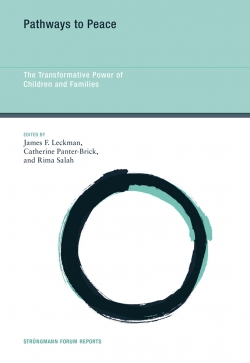Promoting the Capacity for Peace in Early Childhood
Promoting the Capacity for Peace in Early Childhood
Chapter 14 author: Ann S. Masten
Introduction
Conflict and violence show learning and “contagion effects” in children who experience violence, observe it in trusted adults, are coerced to perpetrate violence, or get involved in peer friendships and larger peer groups that encourage violence. Many children grow up under very challenging conditions with frequent violence, yet do not become violent themselves. Scientists and societies are interested in these individuals because they offer clues on how to promote peace-oriented human interactions and prevent or mitigate risks for violence. The link between resilience and peacebuilding involves the idea that human resilience science is the study of processes involved in positive adaptation and development in the context of risks and threats to human function and development.
Conceptual Parallels in Defining Peace and Resilience
Resilience refers to the capacity for adapting successfully to disturbances that threaten the viability, function, or development of a system within and between individuals, social groups, and the physical environment. Good adaptation can be defined by achieving success in expected domains of behavior for a given period of development, culture, and time in history. It can also be defined by negative criteria, such as avoiding mental health problems despite exposure to severe neglect or maltreatment. Individual resilience is better viewed as a set of changing capabilities and resources that arise from the interplay of many systems available to the individual and not a single trait. For example, resilience of a child often depends on resilience of families, which in turn depends on resilience of the community. Some argue that peace implies more than simply harmonious relationships or tranquil state of mind and requires capacity and capability for effectively resolving conflicts without resorting to violence and war. Effective school systems and community support systems previously implicated in resilience science and are becoming more focused on cultural adaptive systems. Resilience scientists noted that the tools we encourage children to develop for learning, could be co-opted later in development into antisocial causes.
Mass Trauma and Resilience
War and disaster highlight interdependence of children, families, and other systems. The presence of violence in a family system in regions that have been experiencing prolonged conflict affects children due to impact on family function. In addition, political violence at macro level cascades into youth microsystems, such as families and schools, which in turn contribute to increasing aggression in young people. The effect of traumatic violence worsens when adversity has already occurred or was ongoing before and after the acute exposure. The length or extent of engagement may increase the youth’s sense of identity and agency in ethnopolitical conflicts. For example, child soldiers in Mozambique viewed themselves as victims if 6 months or less, but members of the army if over the age of six. Prenatal exposure to war and terrorism also may have long-term impacts on stress regulation systems and associated with lifelong health issues and intergenerational vulnerability for PTSD. There is growing evidence that found we can reprogram adaptive systems with therapy or reopening windows of plasticity in brain development in context of positive opportunities to promote specific epigenetic changes.
Early Pathways to Violence and Prevention Research
Antecedents to antisocial behavior and violence has implicated early experiences of poor parenting and family violence. Poor self regulation and noncompliant behavior may lead to problems in school with learning and social relationships and over time, can result in problems in other contexts with elevated risks for antisocial behavior and violence. Physical violence in parenting practices are associated with country-level indicators of life expectancy, educational attainment, and economic well-being. It is suggested in processes explaining the unclear correlation that parental values and knowledge about effective discipline and parenting may shift as acquire more education, perhaps leading to reductions in violence along with improvements in child competence or achievements. Cumulative exposure to poverty and violence may impact capacities for learning and parenting. Prevention research to reduce risk of later misconduct or violence focuses on improving parenting to prevent maltreatment, improve child compliance, and boost child self-regulation skills. Any form of toxic stress, prenatal or postnatal, may alter stress-regulation systems, and repeated exposure to stress hormones harm developing brain and damage neural systems that support development of self-control and learning. This may result in downregulation of the stress system in sustained adversity for some children, leading to insensitivity to stress to protect the brain from excessive exposure to stress hormones and related damage.
Resilience Framework for Promoting Peace
Three primary strategies for promoting desirable outcomes in children at risk for developing problems due to adverse childhood experiences include preventing risk exposure, boosting resources that facilitate desired outcomes, and mobilizing or nurturing protective systems, such as relationships with caring adult or mentors and cultural practices, that foster desired outcomes and reduce impacts of hazardous experiences. There is a considerable amount of work that lies ahead to build conceptual framework, methods, and knowledge based on how to build capacity for peace through early childhood policies and programs.
Competence Begets Competence but Does It Promote Peace?
Early achievements in key developmental areas including positive attachment relationships, compliance, and self-regulation skills lead to later successes, learning, good conduct, social skills, and work skills. Skills like problem solving and self-control are helpful to any type of learning or social interaction. Most interventions with children and youth are involved in intergroup conflict such as gang activity or bullying, and focus on group-level dynamics while also mobilizing children to achieve superordinate goals or increase positive intergroup interactions through cooperative activities.
Does Reducing Inequalities in Health, Education and Opportunities Promote Peace?
It is argued that promoting health development and equality of opportunity also promotes a solid foundation for peace. How it seems unlikely that the foundation alone is enough. What needs to be done in later stages of development, through different contexts, policies, or practices, at local, national, and international levels to reinforce the foundation for peace that has been laid in early childhood?
Three Provocative Questions
Can skills intended for peace contribute to violence? For example, does leading a gang effectively require social skills and knowledge of intergroup relations? Next, can violence lead to peace? And finally, when is conflict or violence adaptive? It is important to consider this adaptive function of violence when designing interventions to promote peace.
JOIN THE CONVERSATION
For breaking news and to stay connected, follow us on social media. Sign up to get our E-News delivered straight to your inbox.

